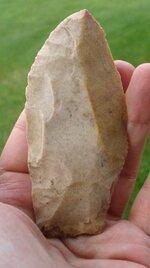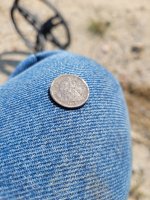uniface
Silver Member
All I know about this for sure is that it's a uniface (what else ?), that it's half of a bi-polar reduction (part of the cortex shows at upper right), that I just got it, and that it was found in the Black Rock Desert, many years ago.
Due to some picture distortion, I was sure it was a big Limace until it arrived. But it's too thin for one, with edge angles too low -- in the knife range. Stranger yet, the lowest inch or so of the sides are ground. Which makes no sense, as the maker couldn't get the (pretty pronounced) bulb of percussion worked off the other side.
A hafted knife (despite the bulb) ?
An abandoned Hell Gap preform ?
A tad over four inches long.
Due to some picture distortion, I was sure it was a big Limace until it arrived. But it's too thin for one, with edge angles too low -- in the knife range. Stranger yet, the lowest inch or so of the sides are ground. Which makes no sense, as the maker couldn't get the (pretty pronounced) bulb of percussion worked off the other side.
A hafted knife (despite the bulb) ?
An abandoned Hell Gap preform ?
A tad over four inches long.
Amazon Forum Fav 👍
Attachments
Upvote
0






